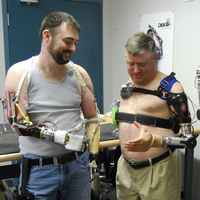If you ask Spc. Daniel McBroom of the Army National Guard, the hardest part of war was the wind. "Physically and mentally, the wind was the worst," he recalls. "This endless hot wind, like 100-degree fans turned toward your body." But McBroom, 23, who returned in June after serving a year in Iraq, says that the toll of war will be different for everyone. "There's no doubt it will mark you, change your body. But I don't think anyone can predict what that change will be."
McBroom is one of nearly 1.5 million Americans enlisted in the U.S. armed forces, all of whom see different sides of war. For those involved in combat -- some 200,000 in Iraq and Afghanistan right now -- the same three phases will shape their experience: training, deployment and reintegration.
After having arrived at pre-deployment mobilization camp, where enlistees spend several months before overseas departure, every man and woman of the American military will be transformed. Physically, their bodies will be examined and immunized -- this year, against H1N1 and anthrax -- and then molded into a robust battlefield warrior. Mentally, they will undergo interactive video training and group counseling, meant to bolster them against the inevitable trauma they'll experience on the ground.

